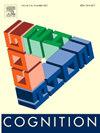Image saliency predicts the expected looking behaviour of other agents
IF 2.8
1区 心理学
Q1 PSYCHOLOGY, EXPERIMENTAL
引用次数: 0
Abstract
When we look at a visual scene, salient features, such as a region of high contrast or a familiar object, attract our attention. Here, we examined how image saliency—based on computational models developed to predict human eye movements—influences how human observers expect the visual attention of others to be directed. We created animations in which a cone-shaped object (the agent) ‘looks’ at complex images displayed in a 3D scene. The agent's looking behaviour was controlled by eye movements recorded from human observers while looking at the same images as the agent or different images. Expectations about looking behaviour were assessed by asking participants (N = 24) to judge whether the agent's gaze was matched to the scene. We find that participants can detect a mismatch between the agent's looking behaviour and its visual environment, based on how the pattern of fixations displayed by the agent align with the visual content of the scene. Discrimination sensitivity was modulated by the overlap between the agent's gaze and salient image features: for example, participants struggled to identify a mismatch when the mismatched gaze aligned by chance with salient features of the displayed image. Further analysis suggests that participants are likely using a combination of low- through to high-level image features to determine the expected gaze behaviour of the agent. Our findings highlight that image saliency models are useful for understanding not only how a person engages with their environment but also their expectations for how others should interact with the environment.
图像显著性预测了其他代理的预期观看行为
当我们看一个视觉场景时,显著的特征,如高对比度的区域或熟悉的物体,会吸引我们的注意力。在这里,我们研究了基于预测人眼运动的计算模型的图像显著性如何影响人类观察者如何期望他人的视觉注意力被引导。我们创建了一个动画,其中一个锥形物体(代理)“看着”3D场景中显示的复杂图像。代理的观看行为是由人类观察者在观看与代理相同或不同的图像时记录的眼球运动来控制的。通过要求参与者(N = 24)判断代理人的目光是否与场景相符,评估了对观看行为的期望。我们发现,参与者可以根据智能体显示的注视模式如何与场景的视觉内容对齐,来检测智能体的观看行为与其视觉环境之间的不匹配。辨别敏感度被代理的凝视和显著图像特征之间的重叠所调节:例如,当不匹配的凝视碰巧与所显示图像的显著特征对齐时,参与者很难识别不匹配。进一步的分析表明,参与者可能会使用低穿透到高级图像特征的组合来确定代理的预期凝视行为。我们的研究结果强调,图像显著性模型不仅有助于理解一个人如何与环境互动,还有助于理解他们对他人如何与环境互动的期望。
本文章由计算机程序翻译,如有差异,请以英文原文为准。
求助全文
约1分钟内获得全文
求助全文
来源期刊

Cognition
PSYCHOLOGY, EXPERIMENTAL-
CiteScore
6.40
自引率
5.90%
发文量
283
期刊介绍:
Cognition is an international journal that publishes theoretical and experimental papers on the study of the mind. It covers a wide variety of subjects concerning all the different aspects of cognition, ranging from biological and experimental studies to formal analysis. Contributions from the fields of psychology, neuroscience, linguistics, computer science, mathematics, ethology and philosophy are welcome in this journal provided that they have some bearing on the functioning of the mind. In addition, the journal serves as a forum for discussion of social and political aspects of cognitive science.
 求助内容:
求助内容: 应助结果提醒方式:
应助结果提醒方式:


